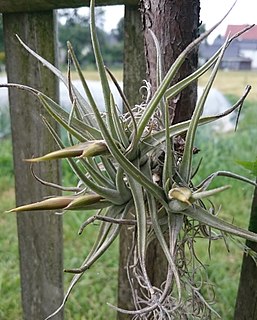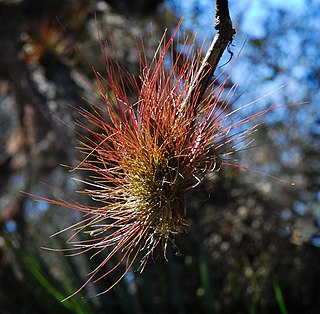
The Bromeliaceae is a family of monocot flowering plants of 75 genera and around 3590 known species native mainly to the tropical Americas, with several species found in the American subtropics and one in tropical west Africa, Pitcairnia feliciana.

Spanish moss is an epiphytic flowering plant that often grows upon large trees in tropical and subtropical climates. It is native to much of Mexico, Bermuda, the Bahamas, Central America, South America, the Southern United States, and West Indies. It has been naturalized in Queensland (Australia). It is known as "grandpa's beard" in French Polynesia.

Tillandsia is a genus of around 650 species of evergreen, perennial flowering plants in the family Bromeliaceae, native to the forests, mountains and deserts of northern Mexico and south-eastern United States, Mesoamerica and the Caribbean to mid Argentina. Their leaves, more or less silvery in color, are covered with specialized cells (trichomes) capable of rapidly absorbing water that gathers on them.
In biology, a monotypic taxon is a taxonomic group (taxon) that contains only one immediately subordinate taxon. A monotypic species is one that does not include subspecies or smaller, infraspecific taxa. In the case of genera, the term "unispecific" or "monospecific" is sometimes preferred. In botanical nomenclature, a monotypic genus is a genus in the special case where a genus and a single species are simultaneously described. In contrast an oligotypic taxon contains more than one but only a very few subordinate taxa.

Tillandsia recurvata, commonly known as small ballmoss or ball moss, is a flowering plant in the family Bromeliaceae that grows upon larger host plants. It grows well in areas with low light, little airflow, and high humidity, which is commonly provided by southern shade trees, often the southern live oak. It is not a parasite like mistletoe, but an epiphyte like its relative Spanish moss.

Tillandsia bartramii, commonly known as Bartram's airplant, is a species of flowering plant in the bromeliad family. It is native to Florida, South Carolina and southern Georgia in the United States as well as Guatemala and Mexico. The name honours William Bartram, an early Florida naturalist.

Tillandsia subg. Anoplophytum is a subgenus of the genus Tillandsia.

Tillandsia stricta is a species in the genus Tillandsia. This species is native to South America and Trinidad.

Tillandsia tenuifolia, the narrowleaf airplant, is a species in the genus Tillandsia. This species is widespread across much of South America and the Caribbean islands.

Tillandsia xiphioides is a species in the genus Tillandsia. This species is native to Bolivia, Brazil, Paraguay, Uruguay, and Argentina.

Tillandsia fasciculata, commonly known as the giant airplant or cardinal airplant, is a species of bromeliad that is native to Central America, Mexico, the West Indies, northern South America, and the southeastern United States. Within the United States, this airplant is at risk of extirpation from the Mexican bromeliad weevil, Metamasius callizona.

Tillandsia ionantha, the air plant, is a species of plant in the genus Tillandsia. This species is native to Central America and Mexico. It is also reportedly naturalized in Broward County, Florida.

Tillandsia capillaris is a species in the genus Tillandsia. This species is native to southern and western South America.
Tillandsia confinis is a species of flowering plant in the genus Tillandsia. This species is native to Venezuela, Bolivia Colombia, Peru, northern Brazil, and Ecuador.

Tillandsia fendleri is a species of flowering plant in the genus Tillandsia. This species is native to the West Indies and South America.
Tillandsia turneri is a species of flowering plant in the family Bromeliaceae. This species is native to Venezuela, Colombia, Guyana, and northern Brazil.

Tillandsia setacea, the southern needleleaf, is a species of flowering plant in the genus Tillandsia. It has a scattered, disjunct distribution in the southeastern United States, northwestern and southern Mexico, Guatemala, the West Indies and the State of Pará in northeastern Brazil.

Tillandsia subg. Tillandsia is a subgenus of the genus Tillandsia.

Tillandsia subg. Aerobia is a subgenus of the genus Tillandsia.












